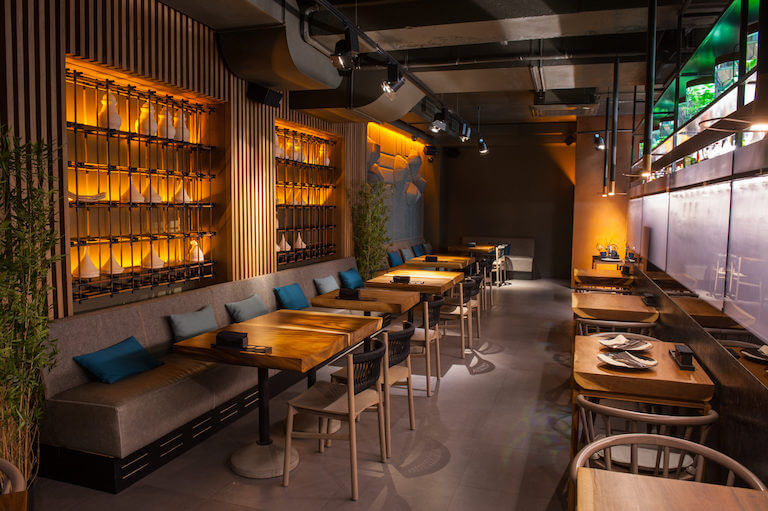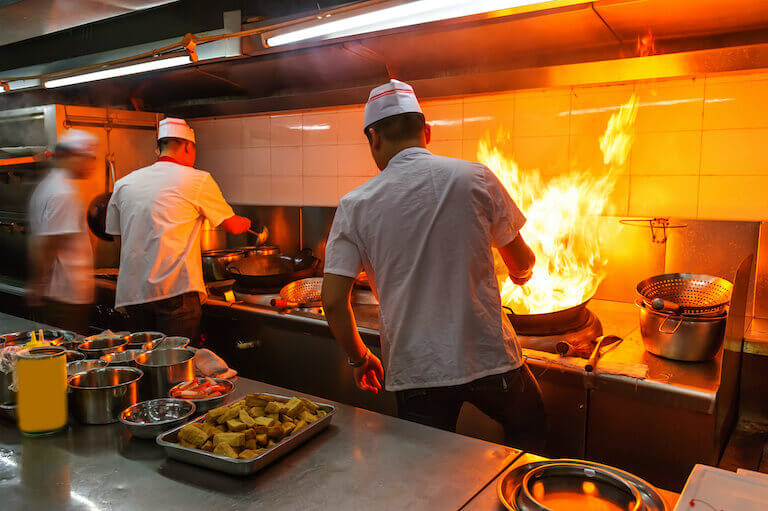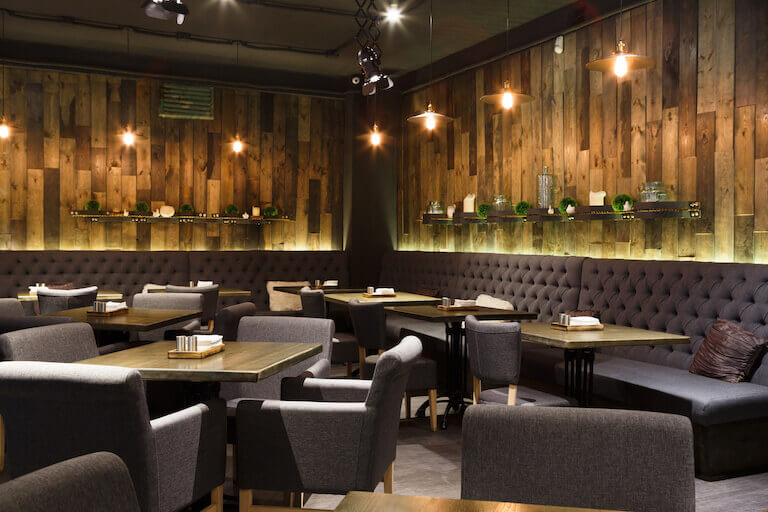Lighting, furniture, decor, music, and of course, food, are the building blocks that make up a restaurant’s ambiance. The difficulty is knowing what to do with each of those elements to get the right result. How can you tell if the vibe is on or off? If business is slow, how do you know what you need to tweak?
There’s no simple formula. But there are some helpful places you can start looking for answers.
Get Your Light Right
Lighting is a crucial part of a restaurant’s ambiance. It sends an immediate message about what to expect; a dining room lit by bright, even light creates a very different expectation than one that’s dimly illuminated by candlelight and subtle accents. Light contributes to your customers’ first impression of your restaurant, so you may want to make it one of your top considerations when thinking about ambiance.
There are three main categories to consider when figuring out how to light your restaurant: ambient lighting, which affects the overall brightness of your dining area; accent lighting, which accentuates specific decorative elements of the dining area to create visual interest; and task lighting, which helps both customers and staff do specific things—like working at the host stand, reading the wine menu at the table, or finding the way to the bathroom.

A combination of lighting sources can contribute to the ambiance of your restaurant.
Try to balance these three types of lighting in order to create the right overall impression for your restaurant. That’s the most important thing—finding what’s right for your restaurant. Different establishments can benefit from different approaches to lighting. Research has found that people feel more comfortable in different light levels at different times of day, preferring brighter light in the morning and afternoon, and dimmer light in the evening. So you may want it brighter if you run a busy breakfast or lunch spot, while dimming the lights for a more intimate dinner experience could be best.
But don’t make it too dim—other studies have found that people can perceive food as tasting more intense in brighter versus darker environments!
Consider Sound from the Guest Perspective
As a restaurant owner, you’re likely already aware of how your menu, staff, and physical environment can affect your customers’ dining experience. But have you thought about noise? Surveys have found that noise is diners’ biggest complaint about dining out—ahead of poor service, crowds, and high prices.
Ambient sounds, music volume, and noisy open kitchens can sometimes be difficult problems for staff and managers to recognize. Sound tends to build gradually throughout a shift, so employees may not notice the incremental change. And over time, servers and bartenders may get so used to the volume that they even develop something called “bar ears”—the ability to pick out conversation across the bar from among the din.
But for a guest who just walked into your restaurant, the volume can be unbearable. Shouting your way through your meal to communicate with your dinner companions is an unpleasant way to spend an evening.

Open kitchens may be trendy, but they can also make your dining room uncomfortably loud.
At Comal, a Mexican restaurant in Berkeley, California, they know how important sound is. The owner is a former band manager, so he knows how to create the right balance. He installed a state-of-the-art system that uses speakers and sound-absorbing panels to either increase or decrease the noise level, based on the time of day and the number of people in the restaurant. It allows the restaurant’s managers to tweak the ambiance to make sure brunches are buzzy but relaxed, and dinners are more upbeat.
But you don’t have to invest in a pricey sound system to make sure your restaurant isn’t uncomfortably noisy. A decibel meter can be a great place to start, giving you an honest reading of how loud the restaurant actually is. And if the problem is ambient noise rather than music, you may need to install some sound-absorbing panels or drapery to help reduce the din to a hum.
Design a Comfortable Floor Plan
Designing the floor plan for your restaurant may seem like a no-brainer—figure out your maximum capacity, and then fit in as many tables and chairs as it takes to seat as many customers as possible. But the reality is that the way you configure your floor plan can have a big impact on your customers’ experience of your restaurant. To that end, you may want to revisit your floor plan when considering changing up your ambiance.
While accessibility guidelines and fire safety occupancy limits provide some basic constraints on how you can lay out your dining room, consider going further than that. Try sitting in every seat in your restaurant and ask yourself, Would I enjoy eating here? It’s important that your guests have enough space to be comfortable, and that your staff be able to move easily among the tables.

The way you lay out your restaurant’s floor plan can play a role in your customers’ experience.
That said, there are choices you can make that can help you hit your dining room’s seating capacity without sacrificing guest comfort. For example, the chairs and tables you choose can play a role here. Square and rectangular tables are more space-efficient than round ones, while bulky, stylized chairs can take up more room than simpler, smaller ones. And as the chairs and tables you select will also represent aesthetic contributions to your restaurant’s decor, decisions about how and where to seat your guests can play a role in shaping the ambiance of your space.
Listen to the Neighborhood
Independent restaurants are often hyper-local; they’re both products of and major contributors to the atmosphere of their specific neighborhood. In other words, what works in one part of town may not be a success just a few miles away. If your concept needs some adjusting, start by looking right in your own backyard.
In Austin, Texas, the owners of a successful gastropub expanded with a new concept in the southern part of town. They purchased an old dive bar and refreshed it into a living room lounge-style cocktail bar with a food truck.
The problem? In this area, in a building that once welcomed the likes of Willie Nelson and Merle Haggard, the trendy vibe and slightly upscale food options weren’t the right fit for the community.
The owners listened, and did a full brand and atmosphere refresh. They changed their name from Nicolaza’s to The Far Out Lounge and Stage, playing on Austin’s musical heyday of the 1970s and the venue’s distance from the expensive downtown area.
Simple white walls made way for the oranges, pinks, and reds of the disco decade. And they went all-in on the music—especially important in “The Live Music Capital of the World,” when many of the city’s old venues are under threat by major development. The stage in their large backyard has live music seven days a week.

Focusing on the features of your restaurant’s neighborhood can help you create an inviting ambiance.
The bar still has great cocktails, and several high-quality food trucks in the stage area give the whole backyard a music festival vibe. Now, The Far Out is one of the most popular dining, drinking, and gathering places in all of South Austin. By taking their cues from the neighborhood, the owners saved their venue and turned it into something more appropriate for the area.
Rely on Guest Feedback
As you start to improve your restaurant ambiance, remember that the best source of feedback is always your guests.
Online reviews are a great place to start. Avoid the grouchy one-star reviews for clues to restaurant ambiance. Instead, look at the three-to-five star reviews, where you’ll find an honest assessment of what people enjoy or would like you to change.

Checking your online reviews can help you find opportunities to improve your restaurant’s ambiance.
You can also ask the waitstaff and bartenders what they hear the most often from guests. Many guests will chat with their servers in person, but won’t go the extra step to leaving an online review.
Ready to Elevate Your Approach to Hospitality?
An education that focuses on the guest experience could be the right starting point to building a restaurant with a can’t-miss ambiance. Auguste Escoffier School of Culinary Arts’ online Associate Degree in Hospitality & Restaurant Operations Management includes elements like working on a restaurant concept and psychology principles that may help graduates to better understand their customers.
If you’re looking to take your approach to hospitality to the next level, then this exciting program—which you can complete from home—may be right for you!
IF YOU’D LIKE TO LEARN MORE ABOUT CULINARY ENTREPRENEURSHIP, TRY THESE ARTICLES NEXT:
- Restaurant Marketing 101: An Essential Guide
- How to Promote Your Restaurant on Social Media
- How To Create A Great Restaurant Menu

